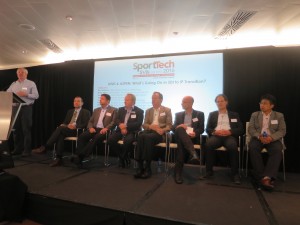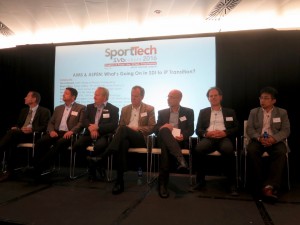SportTech 2016: AIMS and ASPEN – what’s going on with the SDI to IP transition?

Moderator David Fox with (L/R) Simon Reed, Kerry Wheeles, Tim Felstead, Mark Hilton, Amir Hockfeld, Johan Vounckx and Hiroshi Yamauchi
If the broadcast television production industry is to advance into IP-based operation, a new set of standardised protocols is required. Standardisation of course means agreed, shared, open and interoperable – not locked in and proprietary. For our SportTech event in Dublin, SVG Europe brought together senior spokesman from seven leading vendor companies – Avid, Evertz, EVS, Grass Valley, Imagine Communications, SAM and Sony – to explain to our audience what is going on now with the ASPEN Community and the AIMS Alliance and how we can find a path forward that will deliver agreement and ultimately standardisation.
Session moderator David Fox introduced the session by observing that the SDI to IP transition is one “we’ve been promised for many years now, and looks like may finally be happening. Some people have suggested that IP can be a cheap replacement for SDI. Can it help people to work more flexibly, more efficiently and perhaps enable quicker setup? If it features greater reliability and simplicity, then moving to IP could make a real difference.”
Fox reminded the audience that ASPEN stands for Adaptive Sample Picture Encapsulation and AIMS is The Alliance for IP Media Solutions. As ASPEN was the first group to emerge, Fox requested that Simon Reed, Evertz Managing Director UK, lead off the discussion.
“To understand where ASPEN came from you’ve got to roll the clock back a little bit,” said Reed. “For Evertz that was around the 2012-2013 period: at that point we were involved in delivering a very large broadcast infrastructure plant based all around IP for a US broadcaster. We were working at that time with the current standard which was SMPTE 2022.
“It’s very good in certain applications, it’s a very simple method: 2022 simply takes the existing SDI stream and effectively chops it into chunks of data, inserts those into IP packets and delivers them onto the network. At the receiving end you can simply pull those packets off, chuck away the IP headers, reassemble the SDI and you’re back where you started,” said Reed.
“In a live environment, however, we found it had some issues. They were that the embedded audio is very difficult to get to; exactly the same for the data. You’re also encapsulating all of the blanking period, so when you move onto a network, where bandwidth is important, you don’t really want to be encapsulating data that you’re not going to do anything with – wasting bandwidth.
“And it’s fair to say the other thing is that SDI has been with us for 20 years or more now: there’s a lot of legacy in that standard. And by encapsulating it, we’re encapsulating all of that legacy. Is that something we really want to be doing, if we’re moving forward into a brand new environment?” he asked.
“At that time we looked around for alternatives, and one of the standards we did seriously look at is called RFC 4175 which is the video part of the AIMS standard; at that particular time we felt that it was lacking. So we looked around for other ways to do it, and what we came up with was ASPEN. We looked for existing transport technologies, and MPEG-2 transport streams were around and proven – the only thing they didn’t really cope with was uncompressed video.
“So we simply proposed a modification to the headers to allow us to insert ucompressed video, and use all of that proven technology to then deliver the video using the MPEG-2 transport stream. We adopted two other standards: ST 302 for the audio and ST 2038 for the metadata. The key thing you get out of this is that the video and audio are separate.
“It was intended to be an open standard that we could offer out to the industry,” said Reed. “To make that happen we officially launched ASPEN at IBC 2015 and we went on to publish the underlying standard which is called RDD37, which was published through SMPTE in March; and the application programming interface to go with it. And then at NAB just gone we ran a Community booth where we are able to invite people along who were interested in ASPEN and also demonstrate the interoperability of ASPEN equipment, with ten companies involved.
“One of the key things we’ve tried to do,” he said, “is get a range of both broadcasters and manufacturers and also people from the live sports community. A wide range of users. We’ve already deployed a lot of systems that are running live, including some very big broadcasters like ESPN and NBC Sports. To mix it up a bit we’ve done a couple of large-scale trucks for NEP and Game Creek and more recently TV 2 in Norway – now over 50 deployments in total.
“A lot of live events have already happened: Superbowl, NBA All-Starts, The Masters and Rio 2016 are all going to be using ASPEN-based equipment either from ourselves or companies within the ASPEN Community,” said Reed.
“There are still some technical issues to be resolved – and I think this is the important thing when we’re talking about the multiplicity of standards. Evolving new standards is difficult. We’ve run into the burstiness of the data, when it hits the network – particularly if it’s been implemented in a software application.
“There’s a lot of issues still to be resolved with timing. We’re all used to black and burst, which has served us well for 70-odd years. But if you’re moving into a fully IP facility you’re not going to have black and burst, particularly if you start pushing services up into the cloud. So you need something called Master PCR to tie up your facilities. And there’s still a lack of interoperability between some of the key audio standards, primarily the ASPEN ST 302 and the AES67 standard as used as part of TR-03.
“We’re continuing to work on interoperability with other manufacturers,” Reed concluded. “We’re inviting more community members to join. We’re continuing to produce technical specifications – one at the moment on bursty networks. And we’re also working with SMPTE on a proposal to bring a harmonisation in the packet structure that will hopefully bring the VSF TR-03 standard and the ASPEN standard much closer together.
“So where you require both, transferring from one to the other becomes a much easier task. AIMS’ goal is to support open formats including the evolving VSF TR-03 so it made sense for Evertz to support AIMS,” he said.
Agreeing to support the IP roadmap endorsed by AIMS
 To put the AIMS Alliance in context, moderator Fox asked Kerry Wheeles, Chair of AIMS Technical Working Group and CTO Networking at Imagine Communications, to introduce the Alliance and explain how far it has progressed up to this point.
To put the AIMS Alliance in context, moderator Fox asked Kerry Wheeles, Chair of AIMS Technical Working Group and CTO Networking at Imagine Communications, to introduce the Alliance and explain how far it has progressed up to this point.
“AIMS is a non-profit organisation, open to any member who wants to join. It is funded by members and has a number one common goal to foster the adoption of a common ubiquitous set of protocols to support interoperability over IP in the media and entertainment industry,” said Wheeles. “Much as you can buy an SDI connector now from anybody, our goal is essentially that you can buy an Ethernet connector and plug and play in the same way for media and entertainment applications.
“We have over 30 members,” he said. “AIMS was formed five months ago and we already have a plethora of vendors, broadcasters, networks and systems integrators that have joined to consolidate the market into a single set of standards to build on – knowing that is what people are waiting on to actually start moving their transitions in a bigger way. Each member publicly agrees to support the IP roadmap endorsed by AIMS for the broadcast industry.
“In the roadmap,” said Wheeles, “the goal is to separate the three essences, video, audio and data, and be able to pull off the overhead that comes with SDI like all the framing information, and to separate around a single IP link so that you can switch them independently and process them and communicate them – all in a single set of interoperable protocols.
“To achieve this, our first roadmap step was SMPTE 2022-6, because there are many vendors and solutions already supporting this. For many applications that is sufficient: if there are a large number of SDI signals and you’re transferring back and forth around a facility, the SMPTE 2022-6 may be a sufficient roadmap without any need to go further.
“For those that want to be able to do breakaway audio, we support the AES67 standard that is widely used already in the audio environment. And, very importantly, once you pull the audio out you need to be able to keep it synchronised with the video so we back the VSF TR-04 standard — which actually backs 2022-6 for the video, AES67 for the audio and synchronises it with PTP and the SMPTE 2059 standard for timing,” said Wheeles.
“And then, over this year, many members are extending their development to include TR-03, which actually separates the video as well and pulls it out as RFC-4175 – with the AES67 for the audio and SMPTE 2059 to time it all together and then of course the metadata. All of this is feeding into what is becoming SMPTE 2110, which is currently under draft. That is obviously part of this roadmap.
“What makes a standard successful in the marketplace, as SDI has become?” asked Wheeles. “Number one is technical robustness and number two is market awareness, with everyone aware of being able to build on the same thing. In terms of technical robustness, the reason AIMS backs the existing roadmap we just covered is because it are backed by industry groups like SMPTE, Video Services Forum, the EBU, AMWA.
“These are put together with 70 different vendors all doing interoperability tests to make sure that all the little nuances – such as timing and packet bursting, as Simon mentioned – are all worked out to achieve true interoperability,” he said.
Best of breed for healthy competition
For SAM, Tim Felstead, Director of Product Marketing said, “our philosophy is very much the AIMS philosophy. If you went back to where AIMS started, indeed before AIMS started, we were on that path already adopting this set of open standards. So we’re busy implementing it in production switchers, routers, interface systems, conversion systems, signal processors etc. We’re a general manufacturer of all those types of things: I sit between two competitors here (in Grass Valley and Imagine Communications) and I’m quite comfortable to be part of the AIMS organisation with them.”
“My name is Mark Hilton and I’m Vice President for the Infrastructure Business Unit for Grass Valley – that spans all the plumbing we’re talking about here, like the routers and processing and control systems, multiviewers and so on. Similar to my colleagues, we’re all members of AIMS. It’s exciting to see how quickly it has grown and the adoption that has happened.
“I recall, five or six months ago, the very first phone call with my manager Mike Cronk [who’s now the Chairman of AIMS] with one of the companies here today, just to kick the idea off, saying the industry needs this to drive adoption – and now it has taken off like wildfire which is just great.
“We’re also investing in the live area,” said Hilton. “That has been a focus for Grass Valley ever since our inception. We’re trying to innovate in areas we think are necessary to complement the commercial off the shelf [products] that provide IP. We recognise the benefits of those and we want to implement and innovate around those to fill the gaps. We’ve done that and have already launched many of them. It’s an exciting time – not without its challenges – but a very interesting time for the industry.”
“I’m Amir Hochfeld, Senior Product Manager Sports for Avid. We’re also part of AIMS. We found the philosophy of AIMS a perfect match for our vision. We have our open platform connectivity tool to unite workflows and assist broadcasters to combine different workflows. The vision of AIMS fully complies with our technology. Avid Media Central Platform will combine the file-based and stream-based workflows together, to one unified workflow – that goes with the AIMS vision and target.
“My name is Johan Vounckx and I’m working for EVS [as Senior Vice President Innovation & Technology]. The reason we joined AIMS is because basically that’s what our customers expect from us. Our customers want to deploy a combination of best of breed equipment. They don’t want to see a lock-in.
“We really are committed to AIMS and the openness and standardisation that it brings, because we want to compete and believe we have the best equipment around, not because we force our customers to go in one or other direction,” said Vounckx. “If you look at the AIMS roadmap and 2022-6, yes it has limitations. But it is the lingua franca of video over IP today. Everybody on this panel supports 2022-6. It’s not perfect and yes it needs to be extended, and actually that’s what AIMS will bring us. And we will do it together, as an industrial consortium, to make sure that all the equipment be combined as quickly as possible for best of breed solutions.”
 “Hello I’m Hiro”. [Hiroshi Yamauchi, Sony Professional Solutions Europe, Senior Manager, New Technologies & Business Development Europe, 4K IP Production]. “I’m based in Sony Europe. We started with the Sony Networked Media Interface for IP Live very early, in 2013, mainly focusing on UHD live over IP. Since we developed the necessary technology for IP Live, the environment has changed drastically. We developed media transport technology, in terms of how to packetise, and also timing through SMPTE 2059. The other area Sony did a lot of work in was around device discovery around network management,” said Yamauchi.
“Hello I’m Hiro”. [Hiroshi Yamauchi, Sony Professional Solutions Europe, Senior Manager, New Technologies & Business Development Europe, 4K IP Production]. “I’m based in Sony Europe. We started with the Sony Networked Media Interface for IP Live very early, in 2013, mainly focusing on UHD live over IP. Since we developed the necessary technology for IP Live, the environment has changed drastically. We developed media transport technology, in terms of how to packetise, and also timing through SMPTE 2059. The other area Sony did a lot of work in was around device discovery around network management,” said Yamauchi.
“It was very hard to work alone. That’s why you’ve seen the Sony logo in the ASPEN Community and now AIMS. Sony’s objective is to work with everyone to provide our experience through the NMI: not to force technologies on anyone, but to use our technology experience with AIMS and ASPEN to achieve real interoperability through the camera and live production chain.
“As Sony we are very happy to work vendors to achieve practical interoperability. TR-03 and SMPTE 2022-6 are very important for everyone. Our strategy is to be open – we developed our technology by ourselves. We now want to put our material into the discussion, not working alone. That was our big motivation to join AIMS and ASPEN,” said Yamauchi.
Having heard this broad spread of support for the AIMS Alliance and its mission, moderator David Fox then asked Evertz’ Simon Reed why the company has joined the Alliance, if it is the leader of the ASPEN Community. “Are you all going to get along now? What’s the common ground? What are the differences?” asked Fox.
“There has been some attempt to pitch this as a battle between ASPEN and AIMS, or TR-03 as a standard, whereas in fact from the Evertz point of view it was never a battle,” said Reed. “We were simply faced with a situation three years ago where we were trying to deliver IP-based systems and we needed a standard on which to base those systems. We looked around for a technology that we felt would work, and conceived one based on the MPEG-2 transport stream.
“Since then, the AIMS Consortium has been formed and interoperability work has started on the underlying video standard, RFC 4175 – and in fact Evertz has been part of that effort,” said Reed. “We can see that the standard has got a certain amount of weight in the industry. The AIMS aspirations that were published are all good. And Evertz has no particular axe to grind on any standard: that might come as a surprise to many people here!
“We’re an equipment manufacturer, and what we like to do is make and sell equipment. The underlying standard is not important to us; we need a standard that will interoperate with everyone else’s equipment,” he said.
“When we could see that the AIMS group had gained momentum, it simply made commercial sense to join AIMS and we also felt from a technical point of view we can bring these three years of experience we’ve gained in building live systems back into the TR-03 standardisation process to help clarify some of the areas — some of the minor technical issues that are missing from some of the headers that go in the IP packets and so on. We have a lot of experience and we think we can really add to that effort,” said Reed.
